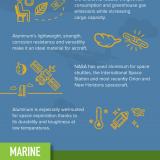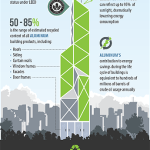Probably one of the most important buzzwords of our time is “Sustainability.” When thinking of the term, mining and industrial metals are probably not the first things that come to mind, but they are in fact integral components of our society’s move towards a greener, more sustainable energy future. We have already outlined how Copper serves as a gateway to renewable energy in a recent post, but the same rationale applies to Aluminum.
Because of its light weight, many car companies have turned to aluminum to be able to comply with government standards and meet consumer demands for increased fuel efficiency and reduced tailpipe emissions. The Automotive Science Group recently concluded that the Ford F-150’s Aluminum design was key to said truck’s “elevated performance, which not only reduces environmental burdens associated with raw material mining and processing, but with reduced vehicle weight, less power is required to physically move the vehicle.” Particularly for heavy vehicles like pick-ups and SUVs, aluminum tends to be the material of choice, with analysts assuming that
“aluminum’s share of the average automotive materials mix in the world is likely to reach 15-16% by 2025, up from approximately 9% in 2015, while the average aluminum content in cars in Europe and North America is expected to increase to 19-20% of the car’s curb weight, up from 10-11% in 2015.”
The use of Aluminum-air batteries, which consume aluminum as fuel and are able to power electric vehicles for up to 1,000 miles, further contributes to increased fuel efficiency and emission reductions.
In the building and construction industry, Aluminum was initially used for decorative purposes and structural strength and durability, but has since been recognized as one of the most sustainable materials available. It is 100% recyclable without loss of properties, and, properly coated, can reflect up to 95 percent of solar energy, thus reducing the need for cooling technologies significantly. As such, builders turn to aluminum to receive the coveted Leadership in Energy & Environmental Design (LEED) green building certification.
Meanwhile, the Aluminum industry itself has significantly reduced its carbon footprint. According to the Aluminum Association, since the early 1990s, greenhouse gas emissions from primary production were cut by 37 percent, while those derived from secondary production were slashed by more than 50 percent.
The Aluminum Association has put together a great set of infographics on the subject. The International Aluminum Institute also hosts a campaign with many examples underscoring Aluminum’s role in the building, and transportation sectors worldwide.
Last but not least, we should also acknowledge that Aluminum’s status as a Gateway Metal to the tech metals Gallium and Vanadium, both of which are critical to renewable energy in their own right, further underscores the metal’s contribution to our sustainable energy future. We will explore both Gallium and Vanadium and their properties and applications in separate posts later this month.







